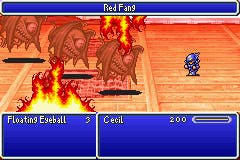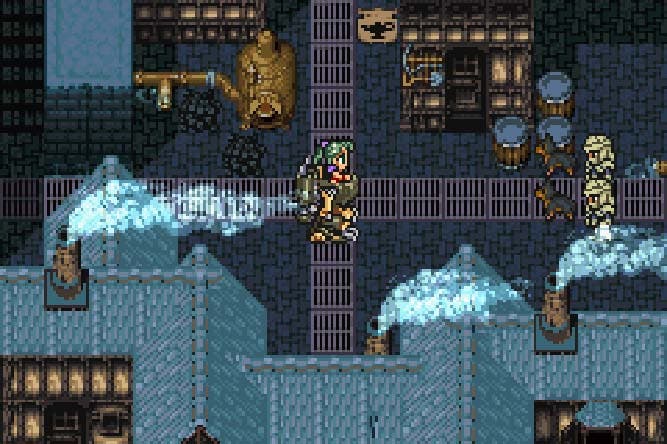Flight of Fantasy
A history of the recurring dream.
Final Fantasy IV

The move from NES to SNES for the Final Fantasy franchise was more than just a simple graphical upgrade - although, thanks to flashy Mode 7 effects and painstakingly detailed sprites, this is certainly one of the best looking SNES games of the era. Rather, this iteration saw Square now promoting plotline from mere incidental to indispensable pivot.
Final Fantasy games since the fourth game have always opened in medea res thrusting the player into the thick of an unfolding situation. Most second rate JRPG stroylines (even today) open in a small village with a young boy awakening to begin a journey on whose outcome the universe's fate seesaws precariously. Conversely, Square in Final Fantasy IV chose as its setting the upper echelons of a politically-charged castle courtroom, the player cast as a powerful knight, who keeps the king's ear: one Cecil Harvey.
The game opens as Cecil challenges his sire's ethics following a vicious sanctioned raid to steal a jewel from a nearby town. Such outspokenness is not tolerated by the king and Cecil is swiftly disgraced, demoted and sent away on a humiliating lowly errand to deliver a package to a remote town. Upon arrival the package reveals its content in the angry violence of a hot explosion. When Cecil awakens the town around him has been destroyed in the blast and its inhabitants mostly killed. He discovers a girl standing over the still body of her mother before, moments later soldiers from the king arrive to confirm his death and kill the girl.
At the time it was an awe-inspiring opening the likes of which had not yet been seen in a JRPG. This core creativity was enhanced for English speakers no end by Ted Woolsey and Kaoru Moriyama's sterling translation work (Woolsey would later be wholly responsible for the even better English translations of Secret of Mana, Chrono Trigger and Final Fantasy VI) and as a result this is one of the first Final Fantasy games to be genuinely enjoyable today.
Notably, the US release of Final Fantasy IV was dubbed Final Fantasy II to maintain continuity (after all, this was only the second game to be released in the territory) but still there was no release for Europe. The US version was severely tweaked: the difficulty vastly reduced to make the game more accessible to westerner newcomers to the genre and risqué graphics such as sprite cleavage on female monsters and bikinis on town dancers were censored (specifically replaced by leotards). The resultant US version of the game was so different from the Japanese one that it was actually re-released back into Japan as Final Fantasy IV Easy-type.
The recent GBA version far more closely resembles the original Japanese version with reinstated plot developments and special moves. In fact, for once Eurogamers get the best deal as the UK version of the game even irons out some technical issues that are present in the US version.
Final Fantasy V

Final Fantasy V was the game that embittered Western fans more than any other. Inexplicably, instead of translating and releasing this, the next Japanese title in the series, Square chose to publish the disastrous part-US developed RPG-lite Final Fantasy Mystic Quest in its place (a game which boasts a storyline so vacuous it can't even really be described as bad).
Fans hungry for the next title in the true Final Fantasy lineage were left to import, Kanji dictionary in hand, and produce printed translations of the story to share amongst themselves. Final Fantasy V was in fact one of the first Japanese-only RPGs to receive a translation patch for its PC ROM image, opening the floodgates to fan localisation.
As a game the emphasis moved from plotline to making the battle system as deep and complex as was possible with the hardware. As a result of this focus several important features debuted. Firstly the Active Battle System (whereby the time which a player took to issue commands to his team became a factor) was made evident. In fact, the ATB system (which would go on to appear in many other Squaresoft games) had been present but hidden in Final Fantasy IV having been designed by that game's planners Hiroyuki Ito and Akihiko Matsui. However, here the player could actually see a gauge indicating how long until his characters and the enemies had before they could make their next attack.
The game also sported the most complete job system (first seen in Final Fantasy III and later further expounded upon in the excellent spin-off, Final Fantasy Tactics) which allowed the player generous customisation of his team (up to 22 different jobs could be mastered). Likewise, this was the first game where chocobos played an active role in the plot. The lead character Bartz is accompanied for much of the game by a yellow chocbo Boco and different coloured chocobos (black) are also revealed for the first time.
Finally released in the west in 2002 as part of Final Fantasy Anthology, and, soon to be released on GBA (it was released in Japan earlier this month), the game plays extremely well today thanks to the job system - an RPG mechanic that has been oft copied poorly but rarely bettered.
Final Fantasy VI

Ask most Final Fantasy fans that came to the party before the seventh game which is the best of the lot and this will be their answer with little hesitation. Many contend that this game, the acme of the 2D RPG, is yet to be bettered by any other role-playing videogame.
What it lacked in PlayStation-style full motion videos it more than made up for with the most graceful plotline of the series (which includes, daringly, the destruction of the world halfway through), and an ensemble cast each member of which is so perfectly pitched a semi-tone between the archetypes that you can't help but fall in love with each one's narrative serenade.
Final Fantasy VI was the first game in the series (and probably of all the JRPGs) to drop the orthodox medieval knights and castles setting in favour of a steampunk industrial landscape. Eurogamer recently had chance to speak with Yoshinori Kitase, director of the game, and asked him what inspired the change of scenario. "Before Final Fantasy VI, most of the RPGs were based on European heroic fantasy kind of world and people in Japan were becoming very bored by that," he said. "We felt we had to make changes to Final Fantasy in order to take into account this fact. At the very beginning of the game design, we had several ideas and orientations not normally drawn upon by RPGs. So for example, the game's opening was inspired by the movie ‘NY 1999' and we based the script around an ensemble cast rather than a single main protagonist. I think that our ideas to bring the spotlight to not one central hero but to an entire group of characters, was the main originality in this game".
Indeed, the game has the largest cast of playable characters of all the Final Fantasy games: fourteen permanent characters and a number of temporary ones including the first playable moogle (Mog). Other notable introductions to the series are the characters Biggs and Wedge (named after Luke Skywalker's wingmen in Star Wars), Espers (which reappear in FFXII) and Desperation Attacks (aka Limit Breaks).
Today Final Fantasy VI remains a marvel of technical achievement both in terms of graphics and Nobuo Uematsu's jaw dropping score (which, at one point includes a spine-tingling aria that stretches the SNES' humble chip vocal chords to sound like a microchip-bound arch-angel). It's a rare example of excellent videogame storytelling, of brilliant localisation and, thanks to some near imperceptible minor chords underpinning the narrative; this is a game that will haunt any player, old or new, to his grave.
As the third game to be released in North America,. Final Fantasy VI's name was changed to Final Fantasy III for the territory. For the 1999 PlayStation re-release the numbering was restored to the original VI. It remains so for the forthcoming GBA release this winter, which will naturally enjoy a Eurogamer review soon thereafter.
Join us again tomorrow for part two, dealing with the PlayStation years, with our review of the US Final Fantasy XII arriving on Tuesday.








